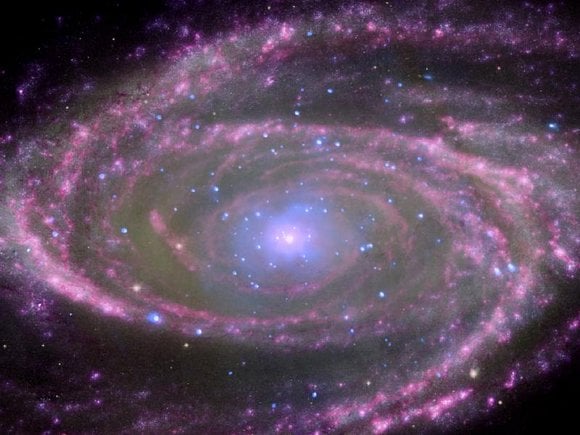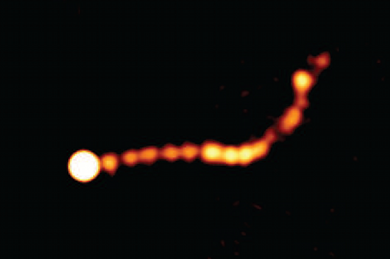This article is more than 1 year old
Black hole spews out 2-million-light-year-long stream of WTF
Boffins spot X-ray blasting, star-stopping cosmic jet
Astronomers have spotted a supersonic cosmic jet blasting two million light years from the centre of a distant galaxy's supermassive black hole.

The jet, which looks like the afterburner of a fighter plane, is moving at nearly the speed of light and its origins and composition are a mystery.
A picture snapped by the CSIRO-managed Australia Telescope Compact Array radio telescope shows a pattern of regularly spaced areas that are brighter than the rest of the jet, just like the afterburner of a plane.
Jets like this one are known to be produced when something falls into the supermassive black hole at the centre of galaxies, but that's all that boffins know about them.
"Massive jets like this one have been studied for decades, since the beginning of radio astronomy, but we still don't understand exactly how they are produced or what they're made of," said Dr Leith Godfrey from the Curtin University node of The International Centre for Radio Astronomy Research.

"If the brighter patches are caused by the same process in astronomical jets as they are in earthly jet engines, then the distance between them can give us important information about the power of the jet and the density of the surrounding space."
The jets are the largest things in the Universe, around a hundred times bigger than the Milky Way and they can affect the most fundamental processes like the formation of galaxies.
"If we want to understand how galaxies form and grow, we need to understand these jets. They are extremely powerful and are believed to stop stars forming in their parent galaxy, limiting how big the galaxies can grow and effecting how the universe looks today," Godfrey said.
The new image shows detail that researchers have never seen before, including the emission of X-rays.
"This particular jet emits a lot of X-rays, which is hard to explain with our current models. Our new find is a step forward in understanding how these giant objects emit so much X-ray radiation, and indirectly, will help us understand how the jet came to be," co-author Jim Lovell from the University of Tasmania said.
The study was published in The Astrophysical Journal Letters. ®
